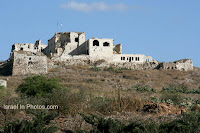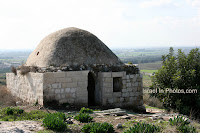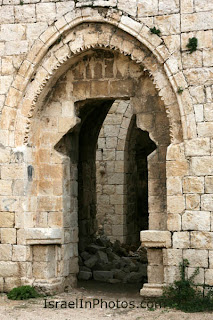The Crusaders of the 12th century recognized the strategic value of this area (the first slopes of the hills to the east from Tel Aphek, about 2 km. west of the Samarian hills), because it formed the eastern flank of the Pass of Afek and they built there a castle, Mirabel (Migdal Aphek).
Nowadays it is absorbed into the disorganized expansion of Sheikh Sadiq.
For the present, the building remains closed to the public.
Many Crusader elements are without effort recognizable, in particular in the north-west tower.
The walls of the keep are 2m thick and the Greek inscription, ``Martyrion of Saint Kerykos'', over the entrance is in secondary use and dates from the 4-5th century.
Kerykos was a young martyr put to death by the Romans in the time of Emperor Diocletian (243-316CE).
Cunningham Geikie (1824-1906) mentioned in his book "The Holy Land and the Bible (1887) Chapter 3-The Plain of Sharon:
"A medieval castle, the Mirabel of the Crusaders, stands on a great mound at Ras-el-Ain, which measures 1,000 feet east and west, and 950 from north to south.
Only the shell of the fortress, however, remains, though the outer walls are very perfect.
Beneath, the springs, welling up at different points, but chiefly on the north, form dark blue pools, fringed by willows, rushes, and canes; a fine stream flowing from them with a somewhat rapid current, while the moisture covers the plain with grass, especially to the south, for several hundred yards."
The village was named Majdal al-Sadiq, after one of its chiefs, al-Sadiq, who led al-Rayyan family, and perhaps it is his tomb (weli), flanked by a tree, that still exists close to the old fortress.











